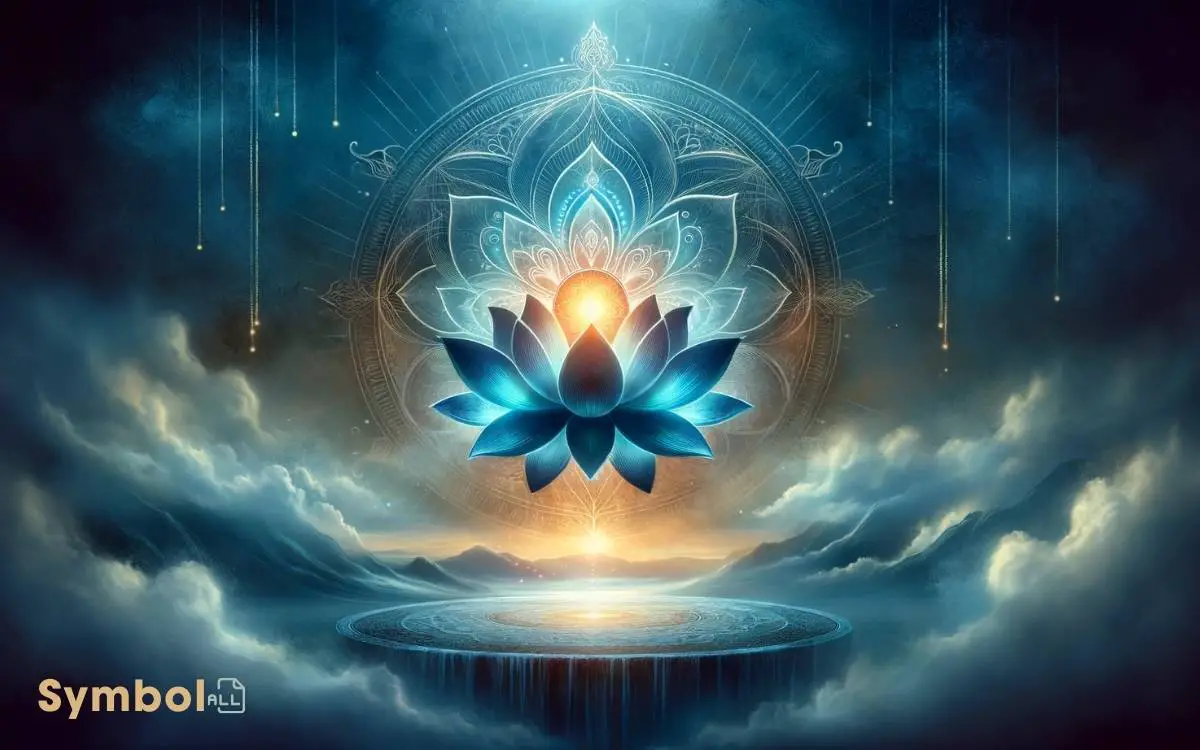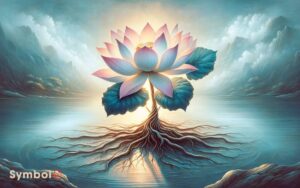Hindu Lotus Flower Symbol Meaning: Purity, Enlightenment!
In Hinduism, the lotus flower stands as a profound symbol of purity, enlightenment, and rebirth. Its significance is deeply rooted in ancient scriptures and artifacts, often depicted alongside deities such as Vishnu and Lakshmi.
This emblem of human resilience and spiritual awakening guides you towards inner purity and transcendence. It represents cosmic balance, encapsulating the cycles of creation and the interconnectedness of divine and earthly domains.
By embodying harmonious integration of material and spiritual spheres, the lotus mirrors the belief in spiritual transcendence amidst life’s challenges. Expanding your understanding of this symbol reveals its role in guiding towards harmony and enlightenment.

Key Takeaways
Historical Significance
The lotus flower holds profound historical significance in Hinduism, serving as a symbol of purity, enlightenment, and rebirth throughout centuries of religious practice and mythology.
You’ll find its roots deeply embedded in ancient scriptures and artifacts, signifying a rich narrative that transcends mere aesthetic appeal.
This emblematic flower emerges from murky waters unscathed, a metaphor for human resilience and spiritual awakening amid worldly suffering.
Its depiction alongside deities, particularly Vishnu and Lakshmi, underscores its integral role in divine symbolism and the cosmic balance between material existence and spiritual liberation.
Through meticulous examination of religious texts, art, and rituals, one discerns the lotus’s enduring legacy a confirmation of its immutable significance in guiding adherents towards inner purity and transcendence.
Symbolism in Hinduism
You’ll find that the lotus flower embodies profound symbolism within Hinduism, representing not only cosmic balance but also notions of purity, enlightenment, and the cycles of creation and regeneration.
Its imagery is deeply ingrained in spiritual texts and rituals, illustrating the interconnectedness of the divine and the earthly.
This symbolism underscores the flower’s significance in illustrating key philosophical and theological concepts. This symbolism of white rose flower is often associated with purity, innocence, and profound spiritual enlightenment. Its delicate petals and pristine color serve as a visual metaphor for the untainted nature of the human soul and the pursuit of higher ideals. Across different cultures and traditions, the symbolism of white rose flower transcends its physical beauty, inviting contemplation on the deeper meanings of life, love, and divine connection.
Cosmic Balance Representation
In Hinduism, the lotus flower represents cosmic balance, symbolizing the harmonious integration of the material and spiritual domains.
This emblematic flower, rooted in muddy waters yet blossoming towards the sky, mirrors the Hindu belief in the possibility of spiritual transcendence amidst worldly challenges.
Its unfolding petals suggest the expansion of the soul, while its unblemished bloom, floating above murky waters, serves as a metaphor for the purity and resilience of spirit in the face of adversity.
This juxtaposition underscores a fundamental principle in Hindu philosophy: the coexistence of duality within unity.
The lotus hence stands not merely as a symbol of beauty or purity but as a profound reminder of the equilibrium between earthly existence and spiritual ascension, guiding followers towards a path of harmony and enlightenment.
Purity and Enlightenment
Building on the concept of cosmic balance, Hinduism views the lotus flower as a potent symbol of purity and enlightenment, reflecting the soul’s journey towards spiritual awakening.
This symbolism is deeply embedded in Hindu iconography and scriptures, where deities are often depicted sitting on or holding lotus flowers, signifying their divine purity and elevated state of consciousness.
The lotus’s ability to rise from murky waters unscathed metaphorically represents the individual’s ascent from ignorance to the light of knowledge.
This change underscores a fundamental belief in Hindu philosophy: that through devotion and moral purity, one can achieve enlightenment, transcending the cycle of birth and rebirth.
The lotus not only embodies aesthetic beauty but also encapsulates profound spiritual teachings central to Hindu thought.
Creation and Regeneration Cycle
Delving into Hinduism’s rich tapestry of symbols, the lotus flower emerges as a powerful emblem of the creation and regeneration cycle, reflecting the universe’s perpetual rhythm of coming into being, flourishing, and dissolving.
This cycle encapsulates the essence of Hindu philosophy, where creation isn’t seen as a one-time event but as a continuous process.
The lotus, blooming unblemished from murky waters, symbolizes the purity and resilience of the soul amidst the trials and tribulations of the physical world.
Its life cycle, from seed to blossom, mirrors the soul’s journey towards enlightenment, transcending the muddy waters of material existence.
Therefore, the lotus flower represents not just physical rebirth but also spiritual rejuvenation, echoing the eternal cycle of life, death, and rebirth inherent in the universe.
Representation in Religious Texts
Several Hindu religious texts vividly depict the lotus flower as a symbol of purity, enlightenment, and rebirth. This representation isn’t merely ornamental but deeply ingrained in the philosophical and spiritual doctrines of Hinduism.
For instance, the Bhagavad Gita, a 700-verse Hindu scripture, uses the lotus flower to illustrate the concept of detached action. It suggests that one should perform duties without attachment, akin to a lotus leaf’s relationship with water.
Similarly, the Padma Purana, which is named after the lotus (Padma in Sanskrit), explores the cosmic symbolism of the lotus.
It associates the flower’s growth from murky waters to unfurling above the surface with the soul’s journey towards enlightenment, transcending materialistic impurities.
Lotus in Hindu Rituals
In Hindu rituals, the lotus flower holds a central role, symbolizing purity and divine beauty in ceremonies and worship practices. Its significance is deeply embedded in the ritualistic traditions, serving as an essential offering to gods and goddesses.
This is due to its unique ability to blossom in muddy waters, representing the emergence of purity from impurity, a concept highly valued in Hindu philosophy.
The lotus is often used in puja (worship rituals), where it adorns altars and is presented to deities as a symbol of the soul’s journey towards enlightenment.
Its presence in these rituals underscores the aspiration for spiritual purity and connection with the divine, embodying the eternal cycle of birth, death, and rebirth.
Relation to Hindu Deities
The lotus flower embodies profound significance for various Hindu deities, symbolizing attributes such as purity, enlightenment, and rebirth.
For instance, Lakshmi, the goddess of wealth and fortune, is often depicted standing on a fully blossomed lotus, signifying her pure, transcendent nature.
Similarly, Brahma, the creator god, is illustrated emerging from a lotus that represents the universe, symbolizing the birth and creation of the cosmos.
Vishnu, the preserver, holds a lotus in his hand as a symbol of beauty, purity, and the unfolding of consciousness.
These representations highlight the lotus’s integral role in depicting the divine qualities of the gods, serving as a visual metaphor for spiritual awakening and purity amidst the murky waters of material existence.
Philosophical Meanings
You’ll find that the lotus flower‘s significance extends beyond its association with deities, embodying profound philosophical meanings within Hinduism.
Its ability to emerge unscathed and pure from murky waters symbolizes purity amid adversity, offering a metaphor for human resilience and spiritual awakening.
Similarly, the flower’s growth pattern serves as a powerful emblem for the path to enlightenment, illustrating the journey from ignorance to wisdom.
Purity Amid Adversity
Amid the tumult of life’s challenges, the lotus flower symbolizes an unblemished purity, suggesting that one can maintain integrity and virtue despite adverse conditions.
This emblematic representation transcends mere aesthetics, delving into the philosophical underpinnings of human resilience and moral fortitude.
The lotus, thriving in murky waters yet emerging immaculate, serves as a metaphor for the human condition. It signifies the potential for purity and enlightenment, notwithstanding the murky waters of temptation, corruption, and moral ambiguity that may surround one’s environment.
This symbolism encourages a reflective introspection on one’s ability to remain untainted by the vicissitudes of life, advocating for a steadfast adherence to one’s core principles and values amid the inevitable challenges that life presents.
Enlightenment Path Symbolism
Delving into the symbolism of the lotus flower, one observes its significance as a beacon on the path to enlightenment, embodying the journey from ignorance to wisdom.
The lotus’s growth, from murky waters to a pristine bloom, mirrors one’s own spiritual ascent transcending worldly mire to achieve a state of enlightenment.
This representation isn’t merely ornamental but deeply philosophical, suggesting that enlightenment is accessible despite one’s origins or circumstances.
Additionally, the lotus’s daily cycle of submersion and resurfacing symbolizes resilience and the constant pursuit of truth and light, essential qualities on the path to enlightenment.
In Hinduism, the lotus doesn’t just symbolize purity, but also the intricate, enduring process of spiritual awakening.
Modern Cultural Impact
The lotus flower’s symbolism permeates modern cultural expressions, reflecting its enduring significance in Hinduism and beyond. You’ll find its imagery in contemporary yoga practices, where it represents purity and spiritual awakening, akin to its traditional roots.
It’s also prevalent in fashion and home decor, symbolizing peace and elegance. Additionally, the lotus has made its way into corporate logos and brands, signifying rebirth and potential, mirroring its ability to bloom from murky waters.
This widespread adoption underscores the lotus’s universal appeal, transcending religious and cultural boundaries.
It serves as a powerful reminder of resilience, purity, and the possibility of transcendence, resonating deeply with individuals seeking meaning and connection in the hustle of modern life.
Conclusion
To sum up, the lotus flower isn’t just a mere petal in the vast garden of Hindu symbolism; it’s a beacon of spiritual enlightenment, deeply rooted in history and philosophy.
Its representation spans from divine purity to philosophical awakening, intricately woven into the fabric of Hindu rituals and mythology.
Like a lotus rising pristine from murky waters, it symbolizes the soul’s journey towards enlightenment, casting a lasting shadow on modern culture with its timeless wisdom.
Its multifaceted symbolism continues to inspire and enlighten, bridging ancient traditions with contemporary values in a harmonious blend of the sacred and the secular.






